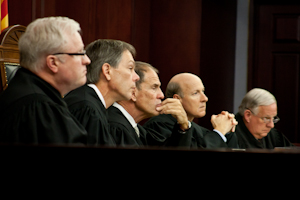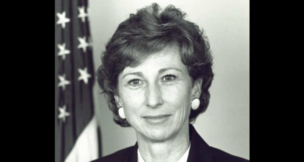Redistricted into a corner: Republicans had too many Maricopa County residents for boundary-drawing panel
Gary Grado//January 21, 2011//[read_meter]
Redistricted into a corner: Republicans had too many Maricopa County residents for boundary-drawing panel
Gary Grado//January 21, 2011//[read_meter]

Unaccustomed to losing, Arizona Republicans are pointing fingers in all different directions to explain how they have found themselves in the middle of a desperate last-ditch struggle to influence who will be responsible for redrawing the state’s legislative and congressional districts.
House Speaker Kirk Adams blames the Commission on Appellate Court Appointments, which, after reviewing dozens of applications, nominated people for the Independent Redistricting Commission. Adams and Senate President Russell Pearce ended up suing the Commission on Appellate Court Appointments, and in a manner of speaking, won two-thirds of a victory by ousting two members of their own party from the list of IRC candidates.
Lee Miller, general counsel for the Arizona Republican Party, said the enemy was the time commitment that redistricting commission members have to serve. Miller said the state party tried to persuade excellent people to be nominees, and many said they couldn’t spare the time.
Mark Schnepf, a Republican and East Valley farmer who was on the Commission on Appellate Court Appointments list until the Arizona Supreme Court tossed him off, said he wasn’t thrilled with the state party’s recruiting efforts.
But when it comes to candid appraisals, no Republican comes close to Senate Majority Whip Steve Pierce, who blamed his party and himself.
Dissatisfied with Republican preparations, Pierce said he took it upon himself to try to find candidates to ensure that rural Arizona cities and towns could exert a significant influence on redistricting.
“I was trying to recruit people from rural Arizona to get their names in,” Pierce said. “I had two from the Verde Valley and three from Prescott, and I probably should have followed up before the due date, and I didn’t. They told me they were going to apply, that they were interested and had the time to do it, but nevertheless, it didn’t happen.”
And that lack of “rural people” — that is, Republican candidates from outside Maricopa County — is what has backed the Republicans into a corner.
The target of Adams’ ire, the Commission on Appellate Court Appointments, had the responsibility of creating a list of 25 names of candidates for the Independent Redistricting Commission: 10 Republicans, 10 Democrats and five independent voters.
The list of Republicans included Schnepf and Stephen Sossaman, also an East Valley farmer.
Their eligibility came into question because they serve on irrigation districts. The eligibility of Paul Bender, a professor at Arizona State University’s law school listed as an independent, also came into question because of his service on two tribal courts. Republicans’ legal claim was that Bender’s role as a tribal court justice meant he had a conflict of interest because Indian tribes have a stake in redistricting. But they also fear that Bender is more liberal than independent.
Under the state Constitution, a person who has served “in any other public office,” other than as a member or officer of a school board, is disqualified from serving on the Independent Redistricting Commission. The provision is generally interpreted to include appointed and elected public offices recognized in state law, but the redistricting language does not address tribal offices.
Adams and Pearce filed a petition with the Arizona Supreme Court on Dec. 30 to challenge the eligibility of the three nominees. The court heard oral arguments on Jan. 18, then a day later ruled that Sossaman and Schnepf were ineligible, but let Bender stay. The ruling said the Republicans didn’t successfully prove tribal service renders people ineligible for serving as redistricting commissioners.
The screening commission was to pick two replacements for the Republicans on Jan. 21.
But as the Republican list stood after the Supreme Court decision, seven of the eight remaining nominees were from Maricopa County.
That’s a problem for the Republicans, as their nominees lack geographic diversity that will greatly determine who can be appointed to the Independent Redistricting Commission.
From the candidates listed by the Commission on Appellate Court Appointments, the four party leaders in the Legislature — Pearce and Adams, plus House Minority Leader Chad Campbell and Senate Minority Leader David Schapira — get to choose one person each.
As speaker of the House, Adams has the first pick, while the second selection is Campbell’s. Pearce and Schapira have the third and fourth picks, respectively. The four individuals chosen then will pick an independent as the fifth member.
At the same time, the legislative leaders have to abide by the Constitution’s mandated geographic and political balance requirements. No more than two of the four appointed commission members may come from the same political party, or the same county.
That requirement could greatly handcuff Pearce, who with the eight GOP nominees left after the Supreme Court’s decision, would be forced to select Pima County resident Benny White in the event that both Adams and Campbell appoint nominees from Maricopa County.
Still, under the best case for Republicans, the Commission on Appellate Court Appointments could select two nominees from outside Maricopa County to replace Schnepf and Sossaman.
But the most recently approved commission list that holds potential replacement nominees includes Republicans who all come from either Maricopa or Pima counties, which leaves the state’s 13 other counties without a potential Republican IRC member.
The narrow pool of Republican nominees has raised questions about the level of preparation and effort put forward by Republicans, although Adams said the criticism is a mere Democrats’ talking point, and he laid the blame for the party’s woes at the feet of the Commission on Appellate Court Appointments.
But, Adams also said he wasn’t familiar with the Republican Party’s efforts to find good recruits.
On the other hand, Pierce, the Senate majority whip, apparently is, as he attributed the lackluster Republican effort to attract IRC applicants, especially rural applicants, to such party lapses as poor planning and the more immediate concerns over midterm elections.
He also blamed poor advertising by the Commission on Appellate Court Appointments.
And even when Pierce tried to help the party, he said he failed to follow through with people he had spoken with, many of whom simply missed the application deadline.
Pierce ultimately helped steer only a single candidate toward the Commission on Appellate Court Appointments. But that candidate, an independent, didn’t make it past initial commission screening.
His drive to find candidates for the IRC still makes him the exception, and not the rule, as there is little or no evidence of larger Republican efforts by lawmakers and the state party to recruit applicants.
“In my opinion, there really wasn’t a recruiting effort,” Pierce said. “That’s what’s happened. The Democrats were out there recruiting people to run, and got plenty of people. Republicans just didn’t do it.”
Sossaman said he was asked by Peter Gentala, the House majority general counsel, to apply, while Schnepf said the East Valley Partnership, a group whose aim is to improve business and quality of life in the region, asked him to apply so there would be the potential for East Valley representation on the commission.
“Quite frankly, the Republicans probably could have done a better job of recruiting more people if they felt like they didn’t get enough good nominees sent to them,” Schnepf said.
Miller, the party’s general counsel, said respective staffs of the party, legislative leaders and the Republican congressional delegation reached out to their constituents to find high quality applicants.
“I know that when you had to be candid with people about what the scope of the job was and what was in it for them, as a commissioner, a number of folks appreciated being considered but wanted to pursue other public service opportunities,” Miller said. “It’s an extraordinary time commitment for no money.”
Steve Lynn, the chairman of the first redistricting commission in 2001, said serving is almost like having a second job for the first few months of the process. That commission finally folded in 2009 after the Arizona Supreme Court ruled in its favor on legal challenges to the legislative map.
Miller said there were people who applied after being contacted by Republicans, but he declined to name any.
He also said “there were a fair number of conversations” about redistricting throughout 2010, but those died off temporarily during the elections.

















